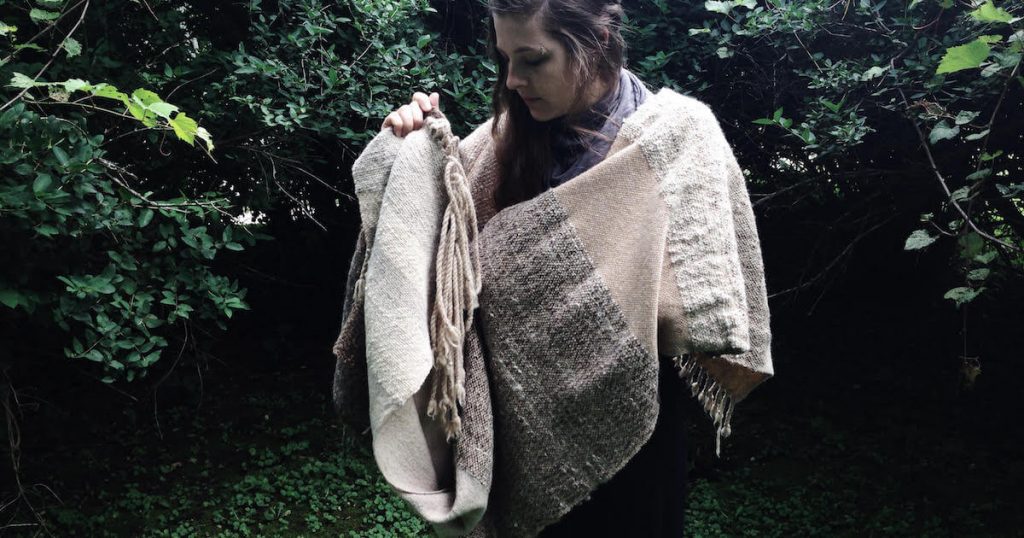
photo by Maddy Bartsch
By Alana Yust | Rewire
Until recently, I had never thought much about where my clothing came from or how it was made. A proud bargain shopper, I purchase most of my wardrobe from clearance racks and outlet malls–and sometimes, clearance racks at outlet malls. For me, clothing has always been a necessity that I buy as needed, without thinking about the many steps involved in producing each piece.
As I’ve taken a closer look at agricultural practices and have tried to add more sustainably-sourced foods to my diet, I’ve also become more interested in clothing and fiber systems. I’m curious about where my clothing–much like my food–is produced and who is making it.
I want to build an ethical wardrobe that was made through safe labor practices, is friendlier to the environment and supports businesses that share my values. My two biggest limitations? Budget and knowing where to begin.
So I sat down with artist, educator and self-described “sustainable fiber systems activist” Maddy Bartsch. Her approach to fashion goes pretty deep.
“I really like personal adornment as a way to wear my values,” Bartsch said. “When someone compliments me, I like to be able to share my values with them and have that clothing be a point of connection.”
Bartsch is the Director of Three Rivers Fibershed, one of a few dozen such organizations in the United States. The first Fibershed was founded in California in 2010 with the idea of reducing the ecological footprint of clothing production. These burgeoning groups are all about connecting local fiber producers (like sheep and alpaca farmers, hemp growers and other small farmers), to the processors, spinners, weavers, apparel designers and artists that can transform raw fibers into wearable pieces.
Three years ago, Bartsch resolved to give up buying any new clothing that was not ethically made and sustainably sourced. Bartsch has successfully built her own ethical wardrobe and has a few tips for those of us with limited purchasing power.
Keep the clothing you already have, longer
Don’t throw out the clothing pieces you already have; instead, keep them wearable as long as possible.
This might seem like a no-brainer, but caring for clothing properly can drastically increase shelf life. Unnecessary or improper washing and drying ages fabrics prematurely, speeding up the rate at which clothing ends up discarded. Follow care instructions and consider air-drying clothing in warm weather months to stretch the life of your current wardrobe.
When it does come time to get rid of an item that’s too worn out to donate, recycle it rather than throwing it out. The nation’s landfills—which is where your tossed clothes will end up—are a major producer of methane, a greenhouse gas linked to climate change.
Buy secondhand for the triple win
Purchasing used clothing from thrift stores or consignment shops can:
- Reduce clothing waste
- Avoid toxic practices and dyeing methods often used to manufacture ready-to-wear clothing
- Provide the value of a new-to-you item at a fraction of the cost
Some thrift stores also have charitable missions, so find a store that shares your values and a portion of your purchase might also benefit a cause you support.
You can also help out these stores by donating your own stuff. Is your favorite pair of jeans on its last leg? Donate them to a thrift store. One man’s trash is another man’s potential upcycle!
And speaking of upcycling…
Learn a new skill
Simple sewing skills like mending and darning don’t require a lot of know-how or large investments of time or money. For the price of a needle and some thread, a few simple stitches can extend the life or your clothing by weeks, months or even years.
Search for introductory classes at local craft and textile stores, or keep your eyes open for community education classes, which tend to be reasonably priced. Some public libraries also have sewing machines for use or loan and may offer free introductory classes.
Buy less, but buy well
Let’s face it, sometimes you just need a new pair of jeans. Buying new isn’t a bad option, but consider paying more for high-quality clothing made with fair labor and environmentally conscious processes. Bartsch recommended thinking about these well-made but potentially more expensive items as “investment pieces.”
“Instead of buy three pairs of pants a year, consider buying one really nice pair,” Bartsch said. “At first it can be a large investment of money because we’re used to pants costing $30 instead of buying one pair for over $100.”
But that price may cover the costs of sustainable production, fair trade and dyeing practices that recover a significant percent of the chemicals used, for example. And, while investment pieces may seem expensive, their cost over time may be similar since they tend to last longer, wear better, and hold more value to their owners.
Start slowly
There’s a lot to learn, especially for those of us brand new to the idea of ethical clothing, and reliable information can be hard to find. Bartsch warned that many clothing companies use ”greenwashing” as a marketing tactic, which she describes as “buying into the trend of being green and using language like ‘natural fiber,’ without actually making any commitments.”
Look for brands that value transparency rather than trendy language, and look for proof to back up their environment- or labor-friendly practices.
Can’t find the info you’re looking for? Demand it! Contact your favorite brands directly to ask, “Who made my clothes?” Look into the #whomademyclothes movement while you’re at it.
It can take time to find designs you like that fit both your body and your budget. Be patient, ask questions and use your purchasing power to make a positive difference.
![]() This article originally appeared on Rewire.
This article originally appeared on Rewire.
© Twin Cities Public Television - 2018. All rights reserved.
Read Next



